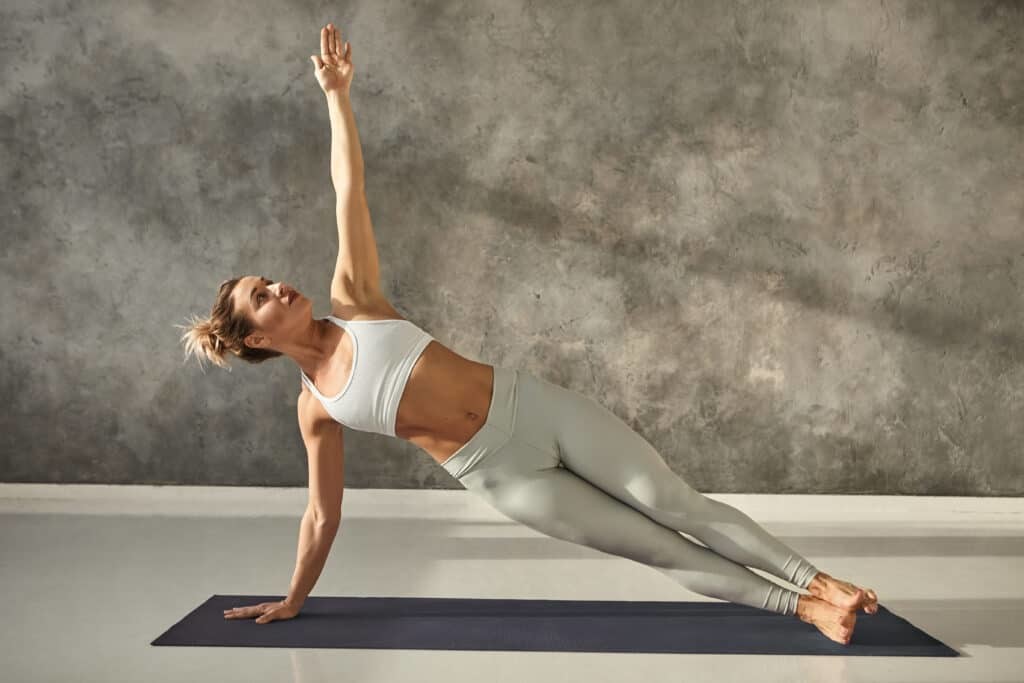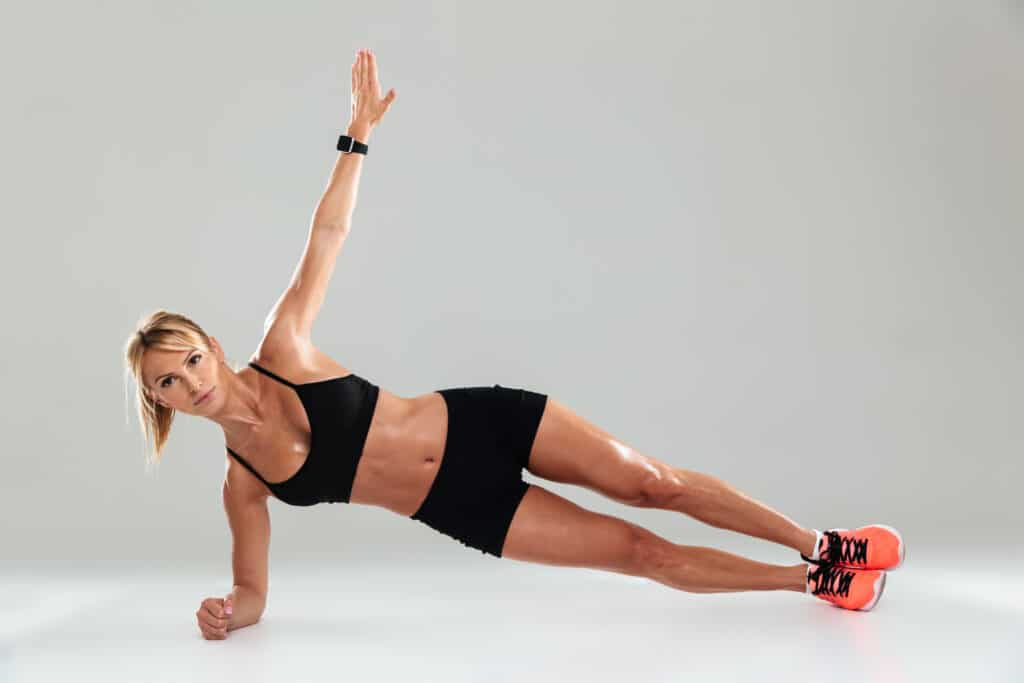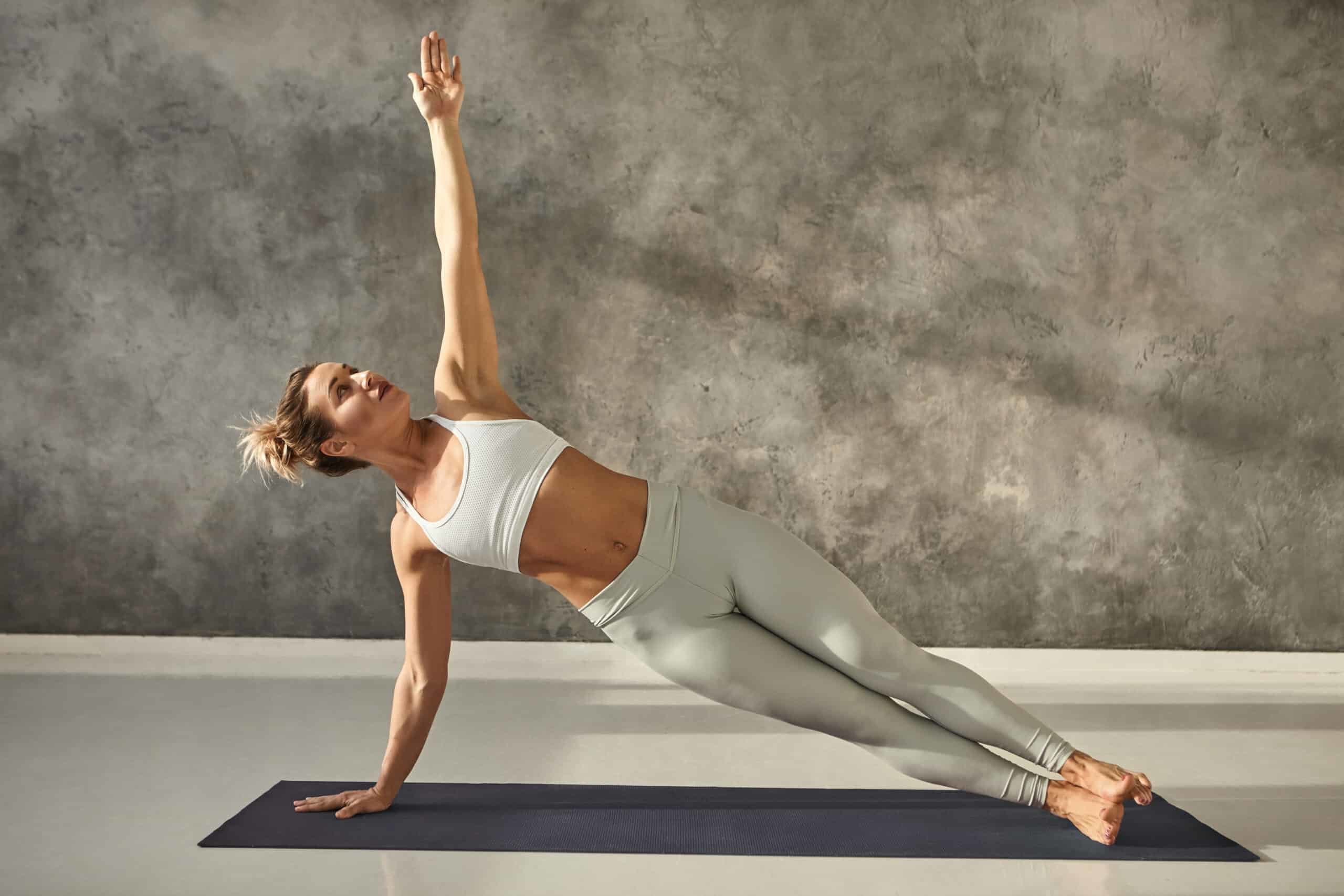The side bridge exercise is a stellar movement targeting the oblique muscles, commonly referred to as the “outer abs.” The various layers of oblique muscles are just one of the 29 muscles that are considered your “core.” This muscle group plays a vital role in posture, core stabilization, activities of daily living and athletic performance. The exercise reveals its true potential, though, by the many secondary muscles it activates while “holding” the position. In addition to the obliques, other muscles like the gluteus medius and gluteus maximus, are engaged to help stabilize the hips. Finally, your shoulder stabilizers work in concert to keep the body aligned as well.
What are the Benefits of the Side Bridge Exercise?
Aside from all the benefits it provides for your body, the side bridge also brings plenty of convenience to the table. It is a terrific bodyweight exercise, all you need to do a side bridge is a mat and a few minutes. The power of the side bridge extends well beyond just your obliques. The side bridge influences every muscle that the obliques touch or are related to. Here are just a few of the benefits of performing the exercise:
- Side bridge activates as much as 40 percent of the upper and lower back muscles. This is more than many common back exercises.
- Not only does it work your obliques exceptionally well (about 50 percent of their maximum), it recruits your rectus abdominals too (about 34 percent of its maximum). This amount of muscle activation is similar to performing a crunch or front bridge exercise (aka plank).
- The side bridge is an ideal exercise to train the back muscles, especially the deep muscle, known as the quadratus lumborum. The QL is an important muscle for providing spine stability.
- Performing the side bridge exercise is one of the best ways to work your hip abductor and glute muscles. The hip abductor muscles work at about 74 percent of their maximum capacity during the side bridge. That number, by the way, doubles the work of the muscle often prescribed for hip muscle weakness, the side-lying leg raise (aka hip abduction).
How to Modify a Side Bridge Exercise
You can do a traditional side bridge or change things up to make the movement easier or harder.
Lift Your Top Leg Up
This increases the stress on the side of the body closest to the ground.
Flex the Hip of the Bottom Leg
This puts all of the weight on your top leg and is the excellent way to train your inner thighs (e.g. your hip adductor muscles). This is a great exercise for any hockey players.
Change Your Point of Support
Rather than supporting yourself from your forearms or feet, you can support yourself from your knees (easier) or from your extended arm (easier on the muscles but harder to balance).
Why is this So Important?
Developing core strength is important for not only posture but every day activities as well. In addition, if you are a runner, triathlete, cyclist or swimmer, then the side bridge should be part of your conditioning program. The side bridge exercise is typically done three times per week, holding the position for 3-10 seconds. Hold the position for a desired time and then roll back. Keep repeating this until you can’t maintain your form. You can also try doing straight sets on one side before switching sides.
The simplest rationale for the side bridge exercise is it builds your muscle capacity providing better hip and trunk stability. The muscles that get strengthened over time, help keep your pelvis level (neutral). This is not only important to prevent back and hip pain but is also very important in preventing knee injuries. One important aspect of knee pain is hip stability and hip abductor and glute medius weakness. The side bridge is ideal for improving stability about the hips and thus preventing or treating knee pain that has been known to cause hip dysfunction.
Trunk Muscles
In addition to providing a great workout for the obliques, transversus abdominis, and rectus abdominis, side bridges work many muscles of the core or trunk. This exercise engages the glutes as synergists, or muscles that help other muscles complete a movement. Side bridges focus on the hips, engaging other synergists such as the quadratus lumborum, psoas major and hip adductors. In addition, additional back muscles such as the iliocostalis and the latissimus dorsi are also activated with side bridges.
Additional Muscles
Side bridges don’t stop at the abs and trunk. Upper-thigh muscles, including the tensor fasciae late, gracious and pectineus act as synergists, as do the deltoids, supraspinatus, and trapezius of the shoulders and upper back. Likewise, the pectoralis muscles of the chest and levator scapulae of the upper shoulders serve as stabilizers, or muscles that help other muscles maintain a certain position during exercise.
Muscle Activation
The side bridge not only excels in the quantity of muscles it engages, it also offers quality activation. Physiotherapist and chiropractor Greg Lehman notes that this exercise engages your upper and lower back muscles at 40 percent of their maximum, a figure far greater than typical back exercises. Lehman also says that the obliques and rectus abdominal experience engagement of 50 percent and 34 percent respectively, making for abdominal engagement roughly on par with crunches. The hips get the biggest benefit, however, at about 74 percent engagement. That’s twice the engagement of the common side-lying leg raise.
Low Back Pain
A 2012 study published in the Journal of Strength and Conditioning Research by the University of Virginia, reveals further benefits of the side bridge exercise for those who suffer from recurrent low-back pain (LBP). The study found that those with recurrent low-back pain experience the same level of muscle activation, or efficient muscle contraction, as those who did not suffer from LBP when performing side bridges. The news is doubly good, as the same study notes that a weak transverse abdominous may actually be part of the cause of LBP.
Stay Strong Together
The award-winning Jefit app comes equipped with an advanced customizable workout planner, training log, the ability to track and share workouts and data with friends. Take advantage of Jefit’s huge exercise database for your strength workouts. Visit our members-only Facebook group. Connect with like-minded people, share tips, and advice to help get closer to reaching your fitness goals.
- 3 Exercises that Will Increase Your Bench Press - December 22, 2023
- 10 Tips to Create Your Best Fitness Routine Yet - December 20, 2023
- Does Losing Body Fat Help Improve Longevity? - December 18, 2023






